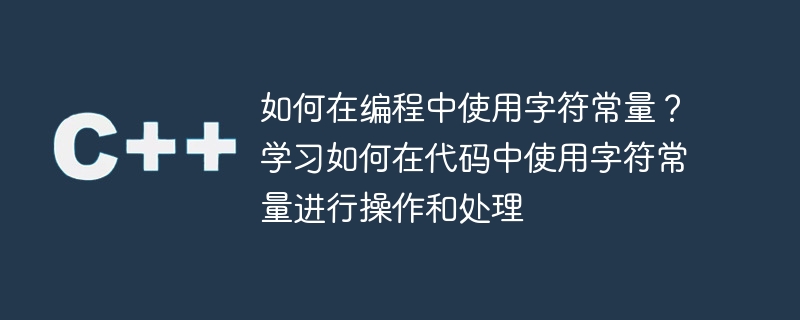Home >Backend Development >C++ >Learn how to operate and deal with character constants in programming
Learn how to operate and deal with character constants in programming
- 王林Original
- 2023-12-27 09:59:401070browse

How to use character constants in programming?
In programming, a character constant is an identifier that represents a specific character. They can be used to perform operations and process character data. In this article, we'll learn how to use character constants in code and provide some concrete code examples.
First, let us understand how character constants are represented. In most programming languages, character constants are represented by surrounding them in single quotes, such as 'A', 'b', '1', etc. These character constants can be letters, numbers, special characters, or escape characters.
Now, let us look at some concrete examples to understand how to use character constants in programming.
- Declaration and assignment of character constants
In most programming languages, variables can be used to store character constants. Here is an example in C:
#include <stdio.h>
int main() {
char myChar = 'A';
printf("The character is: %c
", myChar);
return 0;
} In the above example, we declared a variable named myChar and assigned the character constant 'A' to it . Then, we use the printf statement to print out the value of the character constant. The output will be: "The character is: A".
- Comparison of character constants
In some cases, we may need to compare the values of two character constants. Here is an example in Java language:
public class CharComparison {
public static void main(String[] args) {
// Declare and initialize character constants
char char1 = 'A';
char char2 = 'B';
// Compare the character constants
if (char1 == char2) {
System.out.println("The characters are equal");
} else {
System.out.println("The characters are not equal");
}
}
}In the above example, we declared and initialized two character constants char1 and char2. We then use an if statement to compare the values of these two character constants. If they are equal, the printout is "The characters are equal". Otherwise, the output is "The characters are not equal".
- Operation and processing of character constants
Character constants can be operated and processed with other character constants or variables. Here is an example in Python:
# Declare and initialize character constants
char1 = 'A'
char2 = 'B'
# Perform operations on character constants
concatenation = char1 + char2
repetition = char1 * 3
# Print the results
print("Concatenation:", concatenation)
print("Repetition:", repetition)In the above example, we declared and initialized two character constants char1 and char2. We then concatenate them together using the operator and repeat char1 3 times using the * operator. Finally, we print out the results. The output will be:
Concatenation: AB Repetition: AAA
The above are examples of some basic operations and processing of using character constants in programming. I hope it will be helpful to you. By skillfully using character constants, you can better manipulate and process character data in your code. Remember, character constants are very useful tools in programming for working with a variety of literals and symbols. Different programming languages may have different syntax and rules, so when using character constants, please refer to and study according to the specific programming language documentation.
The above is the detailed content of Learn how to operate and deal with character constants in programming. For more information, please follow other related articles on the PHP Chinese website!

